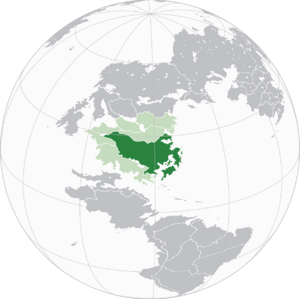Atomic Weapons Board (AwB)
| Atomwǣpnu Bord (AwB) | |
 | |
| Agency overview | |
|---|---|
| Formed | January 16, 1952 |
| Headquarters | Britræᵹ |
| Parent agency | National Defence Research Council (ThNG) |
The Atomic Weapons Board (Fēþisc: Atomwǣpnu Bord)(AwB) is responsible for the design, manufacture, testing, and support of nuclear warheads within the Federated Fire Territories. Britraeg hosts AwB's primary site, with significant facilities also at Faesteah, Britraeg, and Fyrhea.
History
Warhawk tests
Following the conclusion of Project Fenix, the production and manufacture of serviceable nuclear weapons gained paramount importance. Created to oversee this task, the Atomic Weapons Board directed resources, men, and materiel on all subsequent nuclear weapon efforts from January 16, 1952. Under AwB, Project Warhawk saw the testing of three nuclear devices, the Dwarf-1, two, and three, which successfully demonstrated Fyrish nuclear strike capability.
Facilities
AwB's facilities are responsible for the maintenance, design, testing, and manufacture of nuclear weapons. To maintain this capability, AwB operates numerous facilities throughout Fyrland.
Site-A
Site-A (Fēþisc: Steall-A) is the second oldest facility dedicated to the Fyrish nuclear effort. Located in Faesteah, construction started on Site-A in mid-1946, finishing on February 3, 1948. Site-A's primary contribution to the Fyrish nuclear effort is enriching uranium, initially accomplished through the thermal diffusion process. Upgrades later changed Site-A over to the more efficient gaseous diffusion process.
Site-A's efforts were vital to early nuclear exercises within Fyrland. The vast majority of enriched uranium came from Site-A, and its twin Site-B, before other facilities were constructed later. Initially, plutonium-240 contamination from the Britraeg Pile meant that Site-A & B were to provide all fissile material for the nuclear programme. However, this prime importance ultimately proved unnecessary, as later plutonium implosion nuclear devices became viable.
Site-B
Site-B (Fēþisc: Steall-B) is the twin of Site-A and was the third dedicated facility built for the nuclear effort. Also located in Faesteah, construction began on Site-B in July 1947, finishing on May 10, 1949. Although not fully operational until 1949, Site-B provided some limited enrichment capacity from April 1948. Built to enrich uranium in unison with Site-A, Site-B provided uranium enrichment through the calutron process. However, this process was incredibly expensive, which led to the phasing out of Site-B with the conclusion of Project Fenix.
Complex list
This list is not comprehensive.
| Location | Complex | Site | Functions | Status | Built / nuclear contributor since |
Retired / fate | |||||||
|---|---|---|---|---|---|---|---|---|---|---|---|---|---|
| R&D | Pit production |
Material production (U) |
Material production (Pu) |
Component production |
Nuclear testing |
Weapon assembly |
Weapon disassembly | ||||||
| Fæstēah | FAfS | Steall-A | ✕ | ✕ | ✓ | ✕ | ✕ | ✕ | ✕ | ✕ | Active | February 3, 1948 | Still operational |
| Steall-B | ✕ | ✕ | ✓ | ✕ | ✕ | ✕ | ✕ | ✕ | Not active | May 10, 1949 | 1969 | ||
| LoF | LfAF | ✓ | ✕ | − | ✕ | ✓ | ✕ | − | − | Active | 1943 | Still operational | |
| Britræᵹ | BEfL | Steall-Æ | ✕ | ✓ | ✕ | ✓ | ✕ | ✕ | ✕ | ✕ | Active | April 25, 1948 | Still operational |
| LoB | LfAB | ✓ | ✕ | − | ✓ | ✕ | ✕ | ✕ | ✕ | Active | 1943 | Still operational | |
| Hacedaspinca | HpAH | Steall-0 | ✕ | ✕ | ✕ | ✕ | ✕ | ✓ | ✕ | ✕ | Active | November 15, 1945 | Still operational |
| Steall-1 | ✕ | ✕ | ✕ | ✕ | ✕ | ✕ | ✓ | ✓ | Active | November 15, 1945 | Still operational | ||
| Eāræsdenu | ErAH | Steall-13 | ✕ | ✕ | ✕ | ✕ | ✕ | ✓ | ✕ | ✕ | Not active | 1951 | 1969 |
| Steall-14 | ✕ | ✕ | ✕ | ✕ | ✕ | ✕ | ✓ | ✓ | Not active | 1951 | 1969 | ||
| Geoirēlandes | ĒbAH | Steall-7 | ✕ | ✕ | ✕ | ✕ | ✕ | ✓ | ✕ | ✕ | Not active | 1955 | 1969 |
| Steall-8 | ✕ | ✕ | ✕ | ✕ | ✕ | ✕ | ✓ | ✓ | Not active | 1955 | 1969 | ||
| Key | |
|---|---|
| Symbol | Meaning |
| ✓ | Fully capable |
| − | Somewhat capable |
| ✕ | Incapable |